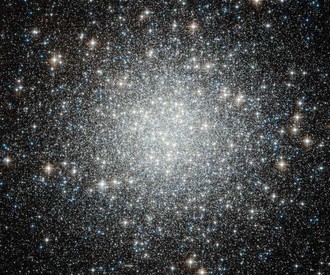
In the recent paper 'MOCCA code for star cluster simulations - I. Blue Stragglers, first results' Arkadiusz Hypki and Mirek Giersz of the Copernicus Center introduce an improved code for simulations of star clusters, called MOCCA, which stands for MOnte Carlo Cluster simulAtor. The MOCCA code is currently one of the most advanced codes for simulating real size star clusters. It follows the star cluster evolution closely to N-body codes but is much faster. Authors show that the MOCCA is a suitable tool to perform full scale evolution of real star clusters and detail comparison with observations of exotic star cluster objects like Blue Stragglers Stars (BSS). BSS are defined as stars which are brighter and bluer (hotter) than the main sequence turn-off point on the HR diagram. Their mass is larger that the turn-off mass, which suggests some stellar merger or a mass transfer scenario for their creation.
We present here only a few selected conclusions from the paper. More details one can find in the full paper on ADS.
Mass ratios for long period Evolutionary Mass Transfer BSS (EMT) fit to the equation q=M_{turn-off}/M_{WD}. In the nominator there are masses of long period EMT, which are just slightly larger than M_{turn-off} (typically 0.1*M_{turn-off} after 500 Myrs). WDs are companions in the long period EMT. Thus, in the denominator there are masses of WDs calculated based on Chernoff (1990, Tab. 1). It shows that mass ratios of long period EMT have a narrow range and predictable values through the entire simulation.
For many BSS there is a significant delay before the actual detection.
Last merger or the last mass transfer can happen even several Gyrs before BSS actually exceeds the turn-off point. This effect was not expected in common scenarios for creation BSS. It was rather assumed, that mergers between stars create BSS immediately. Dormant BSS seem to be important, because there were created overall 112 dormant BSS from the total 476 BSS which is 24%.
Bimodality at 4 Gyrs is not present yet, but signs of bimodality becomes visible after the core collapse at 10 Gyrs . Perhaps bimodal spatial distribution forms always after the core collapse? It will be a great tool to probe dynamical stage of star clusters.
Picture: Blue Straggler Stars in Globular Cluster M53. Image Credit: ESA/Hubble, NASA






